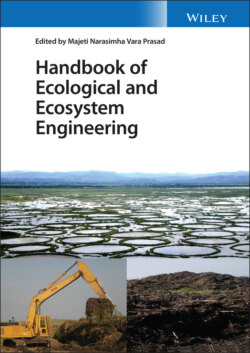Читать книгу Handbook of Ecological and Ecosystem Engineering - Группа авторов - Страница 23
2.2.1 Low Temperature
ОглавлениеDescription of the marginality factor: Low temperature is a physical factor that inhibits, restricts, or avoids the development and growth of almost all plant species since cellular homeostasis is interrupted, enzyme activity is inhibited, and photosynthesis is damaged [10, 47]. Cold affects crop growth and yield [48]. The stress caused by cold induces the disintegration of the cell membrane, reducing the growth and development of plants, e.g. some perennial crops. This is due to the accumulation of malondialdehyde (MDA) as a result of lipid peroxidation in the membranes [49]. Wheat cultivation exposed to 3 °C for 48 and 72 hours showed decreased chlorophyll levels and CO2 assimilation [50]. The effect on transpiration and photosynthesis rates caused reduced activity of ATP synthase, which in turn further restricted the regeneration of RuBisCo and limitedphotophosphorylation [49]. Cold stress can cause oxidative stress in crops, negatively affecting membrane properties and enzymatic activities that lead to necrosis of plants and tissues [51]. Examples of these adverse effects on growth and development were reported in crops like Musa spp., cotton, sugar cane, Nicotiana tabacum, and Brassica juncea [49].
Revitalization by ecosystem engineering: Limitations due to soil located in a cold region or subjected to freezing can be overcome by plants that are adapted to these conditions. Freeze‐tolerant plant species have several strategies to reduce the possibility of freezing their cells and tissues, including maintaining high intracellular concentrations of solutes and nucleating ice outside cells [51]. Interestingly, these plants generally have xerophytic adaptations to reduce conditions of limited water availability in soil. Plants such as winter wheat have the genetic capacity to acclimate, strengthen, and acquire tolerance to freezing down to −20 °C [49]. Cold tolerance can be more easily observed in plant species with enhanced antioxidant enzyme activities [52]. The tolerance to cold stress in alfalfa varieties during the germination phase seems to be associated with increased activity of antioxidant enzymes such as superoxide dismutase (SOD), ascorbate peroxidase (APX), and catalase (CAT) in aerial tissues [53]. Also, exposing soybean seedlings to very low temperatures (1 °C) resulted in the increased activity of antioxidant enzymes [54].
Acclimatization or adaptation to cold can also occur through the synthesis of cryoprotective molecules such as soluble sugars (sucrose, raffinose, stachyose, trehalose), sugar alcohols (sorbitol, ribitol, inositol), and nitrogen compounds of low molecular weight (proline, glycine betaine) [55]. Other plants increase the activity of antioxidant enzymes to protect against cold and maintain cellular redox homeostasis. This acclimatization to cold temperature conditions affects the cellular lipid composition, increasing the proportion of unsaturated fatty acids that make up the phospholipids necessary to maintain the functions of the plasma membrane [49].
Plants that show tolerance and adaptability to cold tend to grow slowly. Such plants display C3 photosynthesis and store sugars in underground tissues. These species have developed a very efficient respiratory system, which allows them to mobilize reserves extremely quickly, usually in short growing seasons. The development factors and physiological responses of these plants are under genetic control [55]. Genetic manipulation of plants with these characteristics may confer adaptation to soils in colder climatic regions, contributing to the revitalization of local markets through the production of biomass to feed the bioeconomy. Transgenic plants, whose reproductive organs accumulate glycinabetaine, exhibit greater tolerance to abiotic stresses [56].
The vast majority of C3 species are temperate crops, while C4 species are mainly tropical. Despite the vast majority of C4s being adapted to warmer climates, Miscanthus spp. has some tolerance to cold, evidenced by its cultivation in temperate climates in northern Europe, including Germany and Denmark [57, 58]. Miscanthus spp. appears in late spring and goes into senescence in early autumn in Northern Europe, where it has a shorter canopy period compared to C3 grasses. Recently, some attempts have been made to identify the characteristics of the most cold‐tolerant varieties of Miscanthus spp., and, at the moment, some studies are trying to improve cold‐tolerant Miscanthus cultivars, and specifically ice‐tolerance in the year of establishment, which is expected to produce higher biomass yields across Europe [59]. The productivity of many of these cold‐resistant cultivars will also improve if increasing temperatures (due to climate change) in these latitudes are confirmed. Arundo donax also has a wide capacity for climatic acclimatization and resistance to cold, growing in cold regions as Denmark, Germany, and the United Kingdom [60, 61]. The plants Pennisetum purpureum and A. donax were indicated by Jensen and Eller [62] as biomass crops, candidates for development in temperate European paludiculture due to their high growth and biomass production rates, ease of harvest, and resistance to temporary flooding. In this study, the hybrid C4 of the species P. purpureum showed higher yields and photosynthetic rates than the giant reed (C3), but the latter showed more stable results on its physiological parameters [62]. Genetic characteristics seem to be related to the cold tolerance of other biomass crops such as switchgrass. Switchgrass rhizomes can survive in soils exposed to air temperatures as low as −20 °C [63]. A cold‐resistant variety of switchgrass produced 17.54 Mg dry matter ha−1 in the third year after planting in a sandy soil in the Netherlands at 52° latitude [61]. Annual crops such as cardoon and rapeseed (Brassica spp.) show good tolerance to low temperatures [64].
The type of revitalization discussed in this point has a more economic character: the possibility of introducing those cold‐resistant crop species in an area not previously cultivated may provide further income for farmers. Moreover, introducing a vegetative cover may increase organic matter in the soil, with benefits for biodiversity, soil structure, and erosion control.
